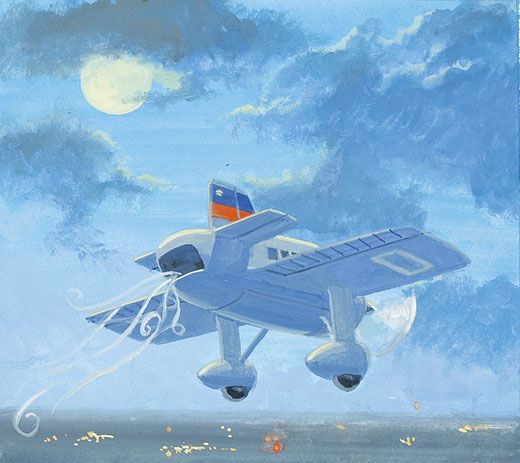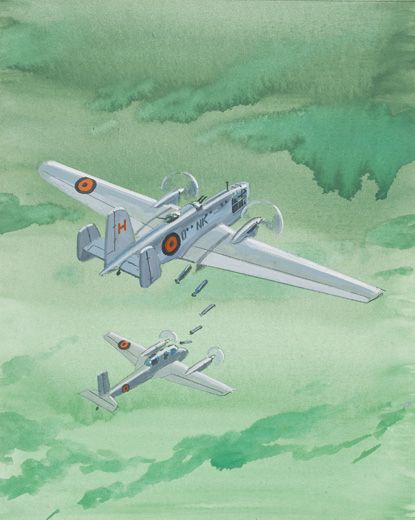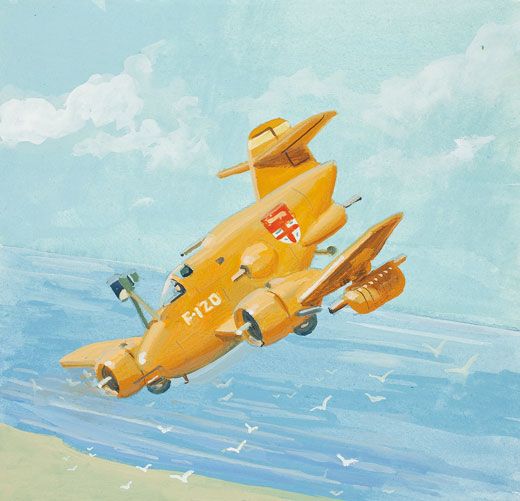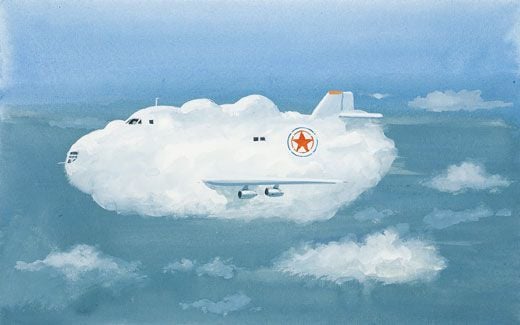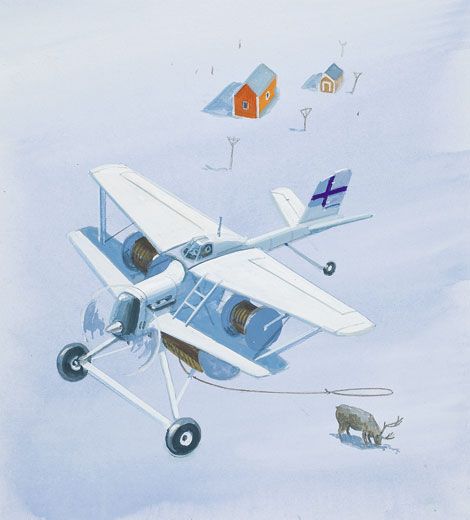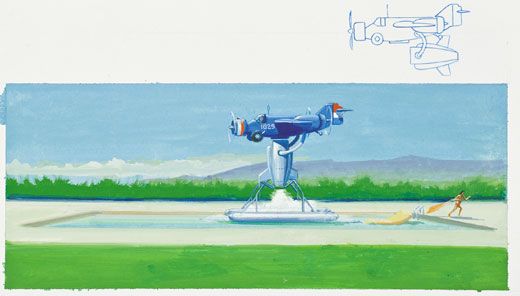The Other Air Forces
Humorist Bruce McCall’s small fleet of little-known aircraft.
/https://tf-cmsv2-smithsonianmag-media.s3.amazonaws.com/filer/Air-Forces-H1-Borp-Bomber-FLASH.jpg)
Britain, France, Germany, Russia, Italy, the United States: Since the dawn of military aviation, all the mighty air forces and great airplanes have come from the same-old, same-old half-dozen nations. Isn’t it time bit players like Albania, Liechtenstein, Paraguay, and Lapland, to name only the most obscure, receive at least a passing nod?
H-1 “Borp!” (“Gotcha!”) Bomber-Bomber, Albania, 1981
Paranoid dictator Enver Hoxha (1908–1985) is credited with the unique concept of the bomber-bomber. Ever suspicious and fearful of coup attempts, Hoxha dictated that whenever an Albanian Air Force bomber took to the air on even the most routine mission, a second bomber must quickly follow to climb high above it, maneuver directly overhead, and unload a bellyful of bombs on the unsuspecting airplane—on the off-chance that its actual, secret mission might be to bomb the presidential compound and overthrow the Hoxha regime. The increasingly nervous strongman had reportedly ordered work to begin on a follow-up bomber-bomber-bomber shortly before his demise. The program was cancelled only a few hours after he was.
DV “Flying Stamp Dispenser,” Liechtenstein Postal Service Air Force, 1968
Counterfeit stamps could wreck the fragile economy of this tiny philately-dependent principality, so nothing less than an instinct for national self-preservation led Liechtenstein’s Postal Service Air Force to devise a “first-strike” doctrine: sending its purpose-designed, twin-engine airplane aloft by night to sneak into San Marino, Luxembourg, and Monaco to dump millions of rolls of counterfeit stamps on these philatelic arch-rivals, sowing mass confusion the next morning and wrecking their stamp industries before they could do the same to Liechtenstein. The stamp commemorating this bold tactic is today a collector’s item, issued by the French possession of St. Pierre and Miquelon, since the Flying Stamp Dispenser is still a Liechtensteinian military secret.
N-78 Flying Cloud, Democratic People’s Republic of North Korea Air Force, 2009
North Korea can claim credit, if credit it be, for history’s most unconventional spyplane. Suspicious that running-dog tricksters of the capitalist-fascist stooge front might be fomenting a diabolical plot in the clouds from the outside world drifting over its airspace, design wizards of the Kim Jong-il Idea Works created the ingenious N-78 Flying Cloud. The four-engine jet was built with parts scavenged from crashed Russian Tupolev and Ilyushin airliners and concealed within a styrofoam shell molded to resemble an innocent cumulus cloud. The N-78 was charged with plowing through every suspect cloud in the sky to foil the dirty work of the imperialist hooligan camp and its lackey dupes. A clever ploy, but perhaps too clever: On its third flight, reports a defecting North Korean meteorologist, the Flying Cloud became lost in the real clouds and was never seen again.
AA “Featherfighter” Pursuit Plane, Royal Fiji Air Defense Command, 1951
Any threat to tourism is a dagger poised at Fiji’s very heart. Pesky flocks of squawking seagulls, pelicans, and goony birds were searching for food scraps and threatening the tranquility of the Pacific island-nation’s beaches, so the Fiji Air Defense Command made chasing them away its primary task. The command devised the Featherfighter MK 1, the world’s first low-altitude, avian-pursuit plane, bristling with compressed-air guns, water cannon, and loudspeakers blaring recorded “Shoo! Shoo! Shoo!” warnings. Alas, beachgoers complained more about the racket of the Featherfighters’ radial engines than about the birds, and the airplanes were redeployed to aid Fijian agriculture by knocking the coconuts out of palm trees—a ticklish low-level operation that soon eliminated the Featherfighters, one by one.
Jokkikikonum XX, Lapp Reindeer Herder Air Force, 1947
The first air force founded by an animal-herding cooperative owed its existence to the traveling aeronautical engineer who, passing through Lapland in 1947, convinced herdsmen that lassoing reindeer from the air instead of chasing them across the vast tundra promised huge savings in time and energy. For the Lapp Reindeer Herder Air Force he designed an aircraft carrying drums of coiled high-strength rope unfurling as air-to-ground lassos, with a World War II Norden bombsight modified to home in on moving animals. Sadly, on the maiden flight, the first lasso wound itself around not a reindeer but a stout spruce tree, and instead of an animal going up, the herders watched an airplane coming down. The Lapp Reindeer Herder Air Force soon lapsed.
P-Q 349 Nutria de Echar Agua (Water Otter), Paraguayan Naval Air Arm, 1978
Jealous of neighbors Brazil, Bolivia, and Argentina with their ocean access and flying boats, the landlocked South American nation of Paraguay craved a naval air arm all its own. The upshot was the P-Q 349 Water Otter, custom designed for the country’s unique maritime environment: Tiny lakes, large swimming pools, and ornamental fish ponds. A stiff aeronautical challenge was solved by using the vertical takeoff and landing principle. The P-Q 349 would hover over its host body of water, kept in midair by the vertical thrust of the jet engine beneath it, before uncoupling, retracting the jet to its position underneath the fuselage (see sketch, inset), jettisoning the disposable floats, and accelerating forward in horizontal flight. What happened when the Water Otter needed to land was a challenge assigned to another, less experienced design team, whose solution as of this writing hasn’t yet arrived. The Paraguayan Naval Air Arm insists that the prototype is still circling over a swimming pool, waiting.
Writer and illustrator Bruce McCall is a frequent contributor to The New Yorker. His last story for Air & Space/Smithsonian was “Ode on a Canadian Warbird” (Dec. 2009/Jan. 2010).
